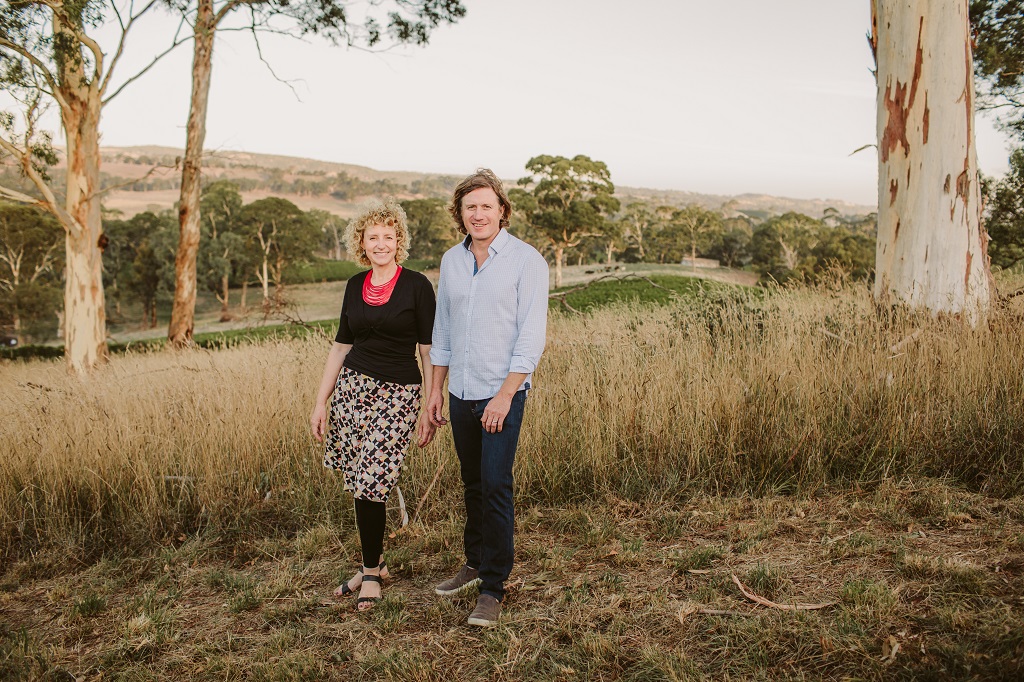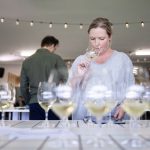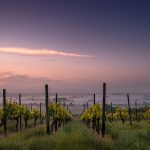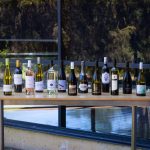Lucy and Darren Golding from Golding Wines in South Australia’s Adelaide Hills.
By Lucy Golding, Golding Wines, Adelaide Hills, South Australia
It all started with a case of mistaken identity, followed by an identity crisis, a struggle to be seen and understood, but ultimately ended happily with an underdog finding a place to put down roots and call home.
Whilst this might sound like the plot line of a Hollywood movie, the main character in this story is actually the little-known white variety Savagnin – a master of disguise, until it wasn’t. It’s introduction to Australia is a tale of serendipity and mistaken identity and whilst its eventual identity reveal caused headaches for many in the industry, we will be forever grateful that it found a home in our Western Branch Vineyard in the Adelaide Hills.
Before I share that story though, I should probably share a little of our own. After both studying and working in the fields of architecture and design, we launched the Golding Wines label in 2002. Darren had been running the family vineyard operations and managing fruit contracts for several years, so we knew we had exceptional fruit and a great site to work with. Our love of cool climate varieties and our optimism surrounding growth opportunities within the burgeoning Adelaide Hills wine region spurred us on to take the plunge and launch our own brand. It was a big year, we got married and launched a wine label within weeks of each other…buckle up!
The Golding family’s viticultural journey in the Adelaide Hills began seven years earlier in 1995 when Darren’s parents, Greg and Connie, sold the family home located in Ashton and purchased 33ha of vacant land just to the east of the Lobethal township. The chosen site, which fell within the Lenswood appellation, had previously been used to grow vegetables, mainly Brussels sprouts. Other than two existing dams on the property there was little else. So began the long process of turning this patch of land into a vineyard, and Darren and Greg worked side by side, with the help of many family members, to make this happen over the next few years. Much of the initial planting material for the vineyard was propagated by Greg in an onsite field nursery. His background in agronomy and extensive knowledge of horticultural practices was an undeniable asset in this process. Darren continues to run our vine nursery business today. The original varieties planted back then were Sauvignon Blanc, Chardonnay, Pinot Noir, Cabernet Franc and Merlot.
Fast forward to 2006, we had taken the helm of the business and were looking to make some changes and plant some new varieties. First on our wish list was Albariño. There was an undeniable buzz around this aromatic and textural white Spanish variety in the market at the time. We enjoyed drinking it and we thought our site, with its elevated aspects and free draining soils, would be well suited to growing it. We initially planted half a hectare before following that up with a larger planting of 3.5ha a couple of years later. Little did we know that by 2009 we would be faced with a grim reality revealed by the genetic testing of Albariño source blocks in Australia. There was an imposter by the name of Savagnin in town and, more importantly for us, it was planted in our vineyard and we were heading steadfastly towards our first vintage of what should have been Albariño.
It was a marketer’s nightmare. Savagnin, also known as Traminer or Heida (let’s face it, neither of those were sexy options), sounded very similar to Sauvignon Blanc and consumers were going to be confused. Round table discussions were held with producers who found themselves in the same predicament. There was frustration and general sense of ‘so what the heck do we do now?’. Many pulled vines or grafted them over; in their eyes a market had disappeared overnight. For many, selling Savagnin was put in the too hard basket in a market where consumers were hungry for a popular Spanish drop and not an obscure and ancient variety grown in the Jura region in the French Alps.
As we hadn’t yet produced and marketed a wine as Albariño, we decided to take a different approach, stay the course, and we bottled our first vintage of Savagnin in 2009. That was the beginning of our Savagnin story and to be honest we haven’t looked back; we think there is much to love about this variety.

Using fruit from the same site Golding Wines produces two different expressions of Savagnin: the La Francesa Savagnin is made with temperature-controlled fermentation in stainless steel tanks while the Cascara Savagnin is made with prolonged fermentation on skins.
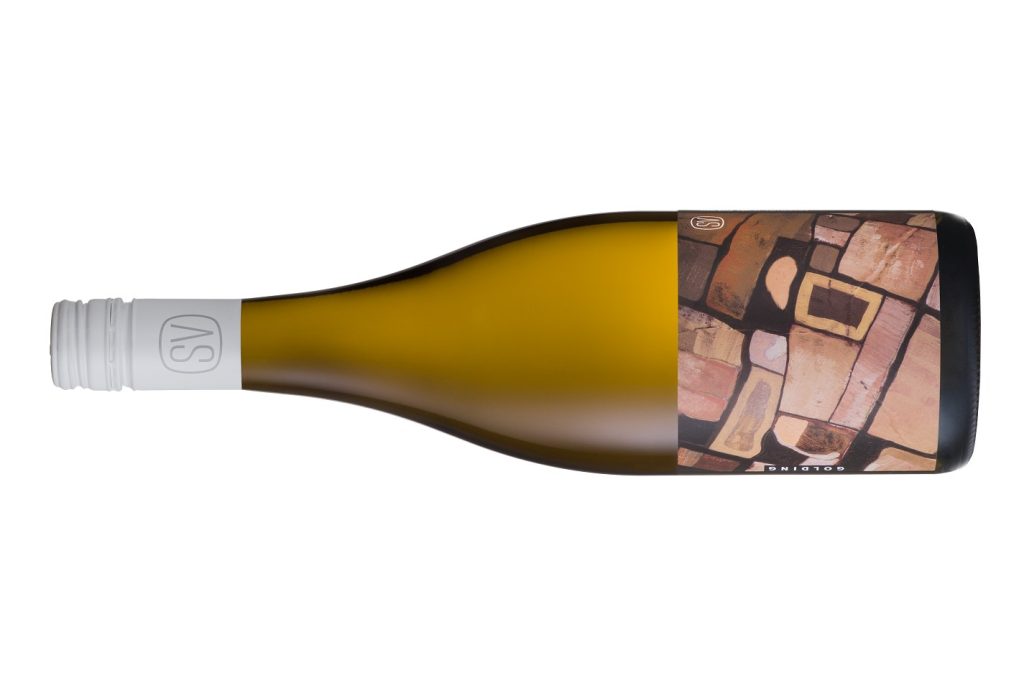
Savagnin thrives in our Western Branch Vineyard. Our vines are grafted on 101-14 rootstock and planted on a high south easterly facing slope at an altitude of around 400m. We spur prune to 30 buds and then shoot thin to maintain the desired crop level. Fruit set can sometimes be variable, but rarely problematic, with a degree of ‘hen and chicken’ that keeps yields moderate. The thick-skinned berries create resilience to disease pressure and provide protection during late season rain events. However, we’ve found that care needs to be taken to control phenolic extraction from the skins when pressing.
When ripe, Savagnin berries develop a pale yellow to burnished gold hue. We pick based on fruit flavour and in a typical season this lands around 12Be. It is a variety known for its high acidity and complex aromatics, and from the one site we produce two different expressions of Savagnin that capture both ends of the stylistic spectrum.
Our La Francesa Savagnin is made with clean temperature-controlled fermentation in stainless steel tanks. This results in a bright, aromatic wine with notes of lemon, pear on the nose, plenty of citrus and a hint of spice on the palate, balanced with the texture and subtle phenolic characters produced by those skins.
Our Cascara Savagnin sits at the other end of the spectrum, made with prolonged fermentation on skins, creating a wine in a more traditional, oxidative style with plenty of texture. It has pronounced nutty almond notes, with pithy lemon and dried herbal characters, but retains a tight acid line. Both styles age well in bottle and are fantastic food wines, pairing with a wide variety of dishes, handling plenty of flavour including some chilli spice.
In the early years, post DNA testing and identity reveal, Savagnin definitely faced an identity crisis with wine consumers and wine commentators alike. No one quite knew what to make of this variety that sounded oddly similar to something else and that wasn’t what it was supposed to be. For us it came down to a few simple questions: is it suited to our site, do we enjoy the wines we are making and are we prepared for the ongoing process of education it would take to bring consumers along with us on this Savagnin path? Yes, yes and yes.
Fourteen years on from our first vintage of Savagnin we still delight in the moment a cellar door guest tries the variety for the first time, discovers the flavours and complexity it delivers in spades and leaves with a newfound favourite white. Whilst it might have originally arrived by chance, Savagnin will always have a home in our vineyard.
Savagnin
By Peter Dry, Emeritus Fellow, The Australian Wine Research Institute
BACKGROUND
Savagnin (suh-vuh-YAN) is a very old variety with place of origin likely to be Jura (north-east France). Based on DNA analysis, Savagnin is a parent of several well-known varieties including Sauvignon Blanc, Grüner Veltliner, Chenin Blanc and Verdelho; and thus grandparent of others; for example, Cabernet Sauvignon. Most intriguing is the discovery in c. 2000 that Savagnin and Pinot have a parent/offspring relationship.
Savagnin is known for its distinctive wines in Jura, particularly vin jaune (= yellow wine), an oxidised style similar to flor sherry (but not fortified). It is also used for conventional dry white wines in the Jura.
The global area in 2010 was 1989ha (with the largest area c. 500ha in the Jura). It is also grown in Switzerland, Austria, Slovenia and Czechia. Savagnin has many synonyms including Weisser Traminer (Germany and Austria), Heida (Switzerland) and Traminer Bianco (northern Italy). Savagnin is a member of Traminer family and, unlike the other forms with aromatic and/or reddish berries, it is both non-aromatic and has white fruit.
It was planted in Australia from the late 20th century in the mistaken belief that it was the Spanish variety Albariño. After its true identity was determined in 2009, the number of producers declined. Currently, there are more than 80 wine producers in Australia, mainly in South Australia and Victoria, with McLaren Vale, Barossa Valley, Yarra Valley and Riverland being the main regions.
VITICULTURE
Budburst is mid-season and ripening is early. Vigour is moderate to high with semi-erect growth habit. Bunches are small to medium, well-filled to compact with small berries. Yield can be moderate. It is suitable for spur pruning. Savagnin has average susceptibility to fungal diseases, is considered to be quite hardy and performs well in hot regions with good acid retention.
WINE
Savagnin has proven to be a versatile variety in Australia, with appealing dry and aromatic white wines in fresh styles with crisp acidity. Descriptors include citrus, white stone fruit and spices. It has great potential but suffers from similarity of name with the much better-known Sauvignon Blanc.
For further information on this and other emerging varieties, contact Marcel Essling at the AWRI ([email protected] or 08 8313 6600) to arrange the presentation of the Alternative Varieties Research to Practice program in your region.
This article was originally published in the Spring 2023 issue of the Wine & Viticulture Journal. To find out more about our quarterly journal, or to subscribe, click here!
Are you a Daily Wine News subscriber? If not, click here to join our mailing list. It’s free!
